by Aditi | Jun 18, 2012
Akwaaba Readers!
This summer I am blogging from Kumasi, Ghana. The first year of medical school ended in a blur of moving apartments, taking my last M1 final, hopping out to my high school friend’s bachelorette party/reunion in California, back home to Long Island for a few days of packing and an Indian fusion wedding, and finally out to Kumasi, where I have lived for one week as of today.
Kumasi reminds me of my days in Kovalam and Chennai: the smells, the red earth of the road during the rainy season, the brightly colored hodge-podge of buildings, the lush vegetation of coconut trees and red flowered bushes, the tailoring shops and street food vendors and piles of shoes, pots, and mobiles in plastic stands spilling out onto the streets for sale. In other ways, Kumasi is also different. The Ghanaian cuisine we’ve sampled at the various student canteens here at the Komfo Anokye Teaching Hospital and surrounding medical student hostels where we live do not offer the year-long vegetarian’s haven I enjoyed in Chennai. Of the few vegetarian foods I’ve tasted this past week– a mixture of meals that include a mildly-spicy fried rice called “joloff”, a beans and fried plantains dish named “red-red,” spicy gingered fried plantains with ground nuts bought piping-hot from street vendors as “killie-willie”—my favorite street food is indeed the “killie-willie,” but favorite meal is “kenkey”—a starchy, fermented corn that is served warm within its husk with two types of spicy tomato sauce.
Unlike Chennai or Ann Arbor or New York City, I don’t blend in here. People constantly ask me if I am from India (usually phrased as “Do you have Indian blood?” or not even as a question—simply, “You resemble an Indian”) and are a little confused when I tell them I was born and brought up in the States. Yesterday, Vivian and I were in a Lebanese-owned Target-like store called Melcom, where one Asian man spotted her and tapped his two Asian friends and all three looked at her and waved. She waved back. Her Cantonese ethnicity continues to baffle people when we introduce ourselves as from the US and from the University of Michigan in the hospital wards.
And as in Chennai, I’ve begun similar explorations of the mental health landscape here in Kumasi. Through the Michigan Global REACH program, I am part of a research team of four medical students and we are investigating physicians’ views of coping with stillbirth and infant death and mothers’ experiences with stillbirth, infant death, and post-partum depression. While the topic sounds so heavy when seeing it here written on the page, the first day of interviews last week was inspiring. Listening to one obstetrician’s stories of coping, of loss, and of his ideas of what could be improved, I felt that this was the only path I could take.
Last Friday I had the opportunity to shadow on the Labor and Delivery ward—the head midwife, a feisty, warm woman who daily wears an IPAS pin that states “Women’s lives matter,” told me that it was a slow day and so she was renovating the ward by hanging up pink and blue curtains—and still, on a slow day, I managed to see a caesarean section and my first vaginal birth within a few hours. (Today, she told me that I should have come because the midwives had delivered several babies, including two sets of twins, by noon!) During the cesarean section, my mentor, Vivian, and I stood in the corner, decked from head to toe in scrubs and masks and surgical hats, and our mentor explained to us how the obstetrician was systematically cutting through skin, fat, fascia, and then into the cream-colored uterus. The baby’s head appeared so quickly and it emerged, covered with the white residue of amniotic fluid, dangling from the obstetrician’s grasp. A house officer cut the green umbilical cord and a midwife whisked the writhing baby away into an incubator in the corner of the theater. As the physicians sutured the incision across the woman’s belly, my mentor told us that their techniques were incredibly efficient, and had to be, given that they practice in a low-resource setting.
by Aditi | Dec 26, 2011
Hello Readers!
This Winter break I’ll be writing quite a few posts to give you all a much-belated glimpse of my first-year med school experiences during the fall semester. Let’s begin with the last week of September, which was our first week of Clinical Foundations of Medicine. During this one-week sequence that occurs five times during our first year, we attended lectures and seminars dealing with ethics, health policy, health disparities, and shadowed, met with a provider of alternative medicine, and visited a site that provides healthcare for an underserved population. I was assigned to shadow the director of the Breast Imaging Department, and while I’ve never pictured myself as a radiologist, the four hours of learning to identify calcifications in mammogram readings, observing physicians perform breast ultrasounds, seeing an image of a breast implant, witnessing conversations between patients and doctors about life-changing healthcare decisions, and listening to residents praise their comfy chairs, the great workday of 7 am – 4:30 pm, and deplore the job scene for radiologists completely opened up a world I had never thought about.
The student-run Curriculum on Health Disparities and the Underserved (more on this in another post I will write this break about opportunities at the med school to work on health disparities education and health equity promotion in the community) planned a series of visits for small groups of M1’s to sites that provide healthcare for an underserved community. Subsequently, we discussed our experiences in small groups run by pairs of M2’s. Normally, physicians who are interested in medical education are matched with a small group for two or more years and they meet with the small group almost every week to discuss a specific case and theme. But having M2 students facilitate our discussion about our experiences and health equity issues was a refreshing change–students in my group became much more vocal and we argued about issues such as whether medical schools should have a more overt dedication to social justice, if medicine is just another profession and if not, what makes it more than a profession?
The sites my peers visited included Joy-Southfield, a center in Detroit that focuses on healthcare, youth programs, housing, and neighborhood revitalization, a women’s correctional facility, a substance-abuse rehabilitation center, and Planned Parenthood. Since commencing medical school, one of the groups I’ve found a passionate community within is Medical Students for Choice (MSFC). As a member of this group, I thought I wouldn’t learn too much more from my assigned visit to Planned Parenthood. However, from my visit I learned about specific legislation in Michigan regarding abortion care that made me realize just how many more barriers to care exist in Michigan compared to in my home state of New York. As our chapter of MSFC attended the National Conference in November, I’ll be blogging more about this later in the break…
After a week of shadowing, visiting clinics, and discussing various aspects of healthcare, a couple of my friends and I drove out to see the movie 50/50, which is a comedy drama about a 27-year-old guy who learns that he has a rare form of cancer (yes, a movie about cancer can apparently be hilarious at times…). Maybe because we had just finished our first CFM week, I found myself paying so much more attention to the cold-hearted physician, his stony conversations with the protagonist, the anesthesiologist who tries to cut short the conversation between the protagonist and his mother right before his operation that has a low probability of success. As I talked to my friends while we walked out of the theater, I realized that all of us had found ourselves paying more attention to these interactions. Soon, our conversations turned to our weekend camping trip (next blog post), but it was interesting to note the changes we were already experiencing as we grow into our med student selves…
by Aditi | Nov 1, 2011
After a month of learning about the heart and lungs, we (first-year medical students) dove into our first day of the musculoskeletal sequence yesterday. This is the most intensive sequence in terms of the amount of anatomical knowledge to be mastered and the time spent dissecting in the anatomy labs. Yesterday, our first dissection for this sequence was to skin the arms of the cadavers.
The first time we dissected, I held my breath as my anatomy teammate slid the scalpel down the back of our cadaver. I was amazed at how easily the skin can be sliced through and parted. Two months later, I am now comfortable using scalpels to cut through skin and fascia and muscle, pliers to break the ribs in order to explore the thorax, and fine probes to comb out delicate nerves. However, yesterday I was still apprehensive when reading the portion of our lab manual describing the steps of skinning the cadaver in order to unearth the numerous nerves, veins, and arteries of the arms. But as usual, my teammates and I appeared at our dissection table donned in scrubs and white lab coats. We uncovered our cadaver and clipped new blades onto our scalpels. Normally the hands of our cadaver are wrapped in bags. But the first step of our dissection was to remove these bags. The hands of our cadaver still had all ten nails intact—smooth and polished. We started to slide our scalpels through the arms, delicately pulling apart the skin, snipping away at the layers of yellow fat, teasing out the larger stretches of violet veins and the delicate nerves. It was easier than I imagined it would be—perhaps because of the excitement of uncovering a fragment of a nerve or finding the cephalic vein that till now I had only seen on an anatomy flashcard. Still, after catching a glimpse of the fingers of our cadaver with its few hairs and nails while dissecting the upper arm, I temporarily covered the hands with the edges of the cloth that covered the lower portion of the body.
Later, I joined a long line of students in order to receive an individual box of human bones in order to (theoretically) study osteology during subsequent sequences. As I walked back home, someone stopped me and asked what was in the long gray boxes that I and some ten other students were carrying. “Bones,” I casually replied. He asked, “Not human, right?” I laughed and said that of course the bones were human ones. He raised his eyebrows and said, “Well that’s a nice way of celebrating Halloween.”
by Aditi | Sep 14, 2011
Dear readers,
Two months ago I was reading a Murakami novel on a beach in San Juan, Puerto Rico and since then I have moved from New York City to my much larger, cheaper, and sunnier apartment in Ann Arbor and experienced (and have enjoyed, and sometimes barely survived) six weeks of the first year of medical school. Here are a few glimpses of my path in returning to school after two years of adventuring, moving to the Midwest, and easing (and sometimes hurtling) into the world of medicine.
Having lived in bustling cities during the past two years, I wanted to live and learn medicine in a quieter place that was vibrant and green (for at least part of the year). The weekly Ann Arbor Farmers’ market has kept my Californian roommate and I happy and well-fed. Farmers from various parts of Michigan (I won’t specify since my sense of Michigania geography is still embarrassingly non-existent) sell peaches, famous blueberry and apple cider donuts, jams, honey almond goat cheese, herbs and flowers, yellow and green cucumbers, fresh bread and yogurt, and most exciting of all–offer free face painting–from 7 am – 3:30 pm every Saturday. While I bemoaned beginning medical school in early August, the market is one of Ann Arbor’s summer-fall treats that has eased my transition.
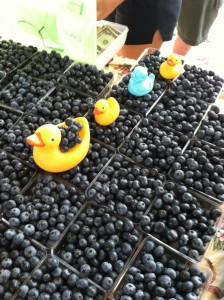
Michigan blueberries are deliciious and strangely presented...(Photograph taken by Alissa Petrites, M1)
Last Saturday, a few fellow students and I went to a free evening festival hosted by the farmers’ market. As all of us were still studying for a weekend quiz (you may be able to detect the immense backpack I am carrying in the photograph below), this several hours-long study break of $1 wine tastings, live music, sunlight after a week of rain, and some twenty free samples of asiago pesto bread, almond espresso brownies, watermelon gazpacho, and organic arugula ricotta gnocchi completely revived us.
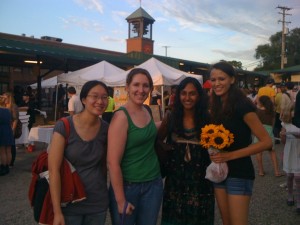
Sunflowers, free food, and a long study break: The Ann Arbor Farmers' Market Festival (Photograph of M1's taken by Cecilia Kwak, M1)
Even on the Saturday of the first football game of the season, I managed to convince my fellow med students to walk through the farmers’ market and buy apple cider donuts on our way to the game. Which brings me to the inevitable topic of football. Till now, I have never been interested in football. During the student panel at the Michigan interview day last year, I grew tired of the football talk and asked (perhaps annoyingly) about spaces for the arts in the medical school. But as luck would have it, a few friends convinced me to buy a ticket to the football game two weekends ago. As I entered the Big House for the first time, I could hear and feel and finally see a yellow and blue sea of some 100,000 people that completely engulfed me. First-year medical students (M1’s) get seats extremely close to the field (is that what it is called…?) and have spectacular views. Here are a few photographs taken by Bianca Verma, M1 photographer extraordinaire:
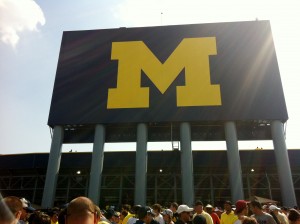
The M will engulf one and all.
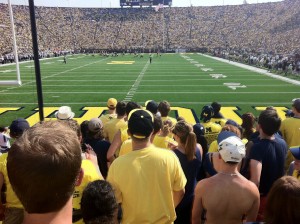
The M1 secton's amazing view of the sea of yellow and blue fans (and of the game itself)
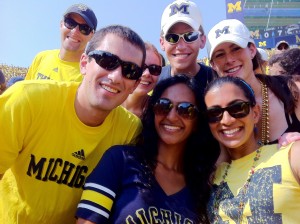
Happy M1's
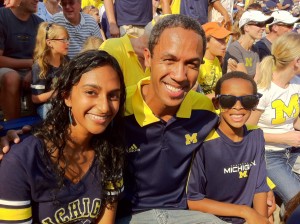
Jonathan and Christian: Ever the diligent student and doting dad, Jonathan quizzed in the morning and in the afternoon brought his son Christian to his first football game.






